It’s winter in Maryland. In fact, it’s so much winter I shoveled 10 inches of snow off my driveway this morning. Fortunately, I had company. It wasn’t the kind of company that picks up a shovel and helps out, but still, the American robins darting back and forth over my head were still welcome (if surprising and surprisingly quiet) snow day companions.
Become a Member
Make a lasting impact for nature when you join The Nature Conservancy
“You know,” I said to them as I leaned on my shovel to watch about 25 birds flock together in my neighbor’s oak. “I think y’all are a little early—aren’t you supposed to be the first harbingers of spring?”
We’re not even a month past the first day of winter in the northern hemisphere. Spring is definitely not here. So why are the robins? Shouldn’t they be sunning themselves in warmer climes?
The short answer: as long as there’s food, American robins—true to their name Turdus migratorius (“the wandering thrush”)—kind of spend their winters coming and going as they please.
Robin Migration (AKA Robin Wandering)
Robins do migrate—but they don’t necessarily follow a more or less straight line from north to south in the fall, then repeat the journey south to north in the spring. In the fall and winter, when the ground freezes, robins lose access to their meal of choice: worms, insects (adult and larval) and (occasionally) snails. That’s when they turn to their winter diet staple: mostly fruit, mostly berries.
The folks at Journey North, a project tracking robin movements run by the University of Wisconsin-Madison, put it this way, “Some robins retreat all the way to southern Texas and Florida (in fact, some of the largest winter flocks documented by the Christmas Bird Count gather in sunny St. Petersburg, Florida), but others winter as far north as they can find berries. So they have an enormous winter range. Robins do migrate, but it has more to do with food sources than with being faithful to the same places year over year.”
In that way American robins are somewhat akin to teenage boys—they tend to go where the best (or most abundant or most easily accessible) food is, stay until it’s depleted, and then move on.
So as long as there are enough berries and other fruits to sustain them, you may see robins off and on throughout the winter across much of North America.
Forget the birdseed though. Robins’ digestive systems, unlike sparrows or other so-called feeder birds, aren’t built for dealing with seed, and their beaks aren’t built for cracking things open. Robin beaks are built for snapping up worms, catching insects, and plucking berries and other fruits. In the winter, a flock of robins can strip a holly bush with impressive speed and efficiency, and very little—if any—violent robin-on-robin aggression.
Food is also one of the reasons that robins, notoriously territorial and aggressive in breeding season, tend to gather and travel in flocks in the fall and winter. Numbers are good for defense, and also for spotting food—if one robin happens on a holly tree full of bright, ripe berries, the whole flock can partake. And then move on.
The tendency of robins to flock in winter may also be one of the reasons people seem to notice them—birds in large numbers tend to stand out when they’re gathered in leafless trees. (That and the beautiful red breast that is sometimes the only splash of color in a winter landscape that looks practically lunar in relentless shades of February white and gray.)
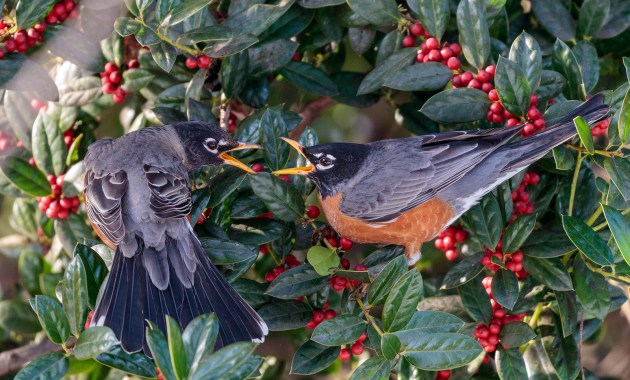
How do Robins Survive the Cold?
Robins are outfitted to survive huge temperature variances. In fact, hot weather seems to stress them more than cold.
If an American robin is healthy, has enough to eat, and is able to main its feathers, the temperature next to its body stays around 104 F—regardless of how cold it is in the world outside. It really is all about those feathers. (And the legs and feet.)
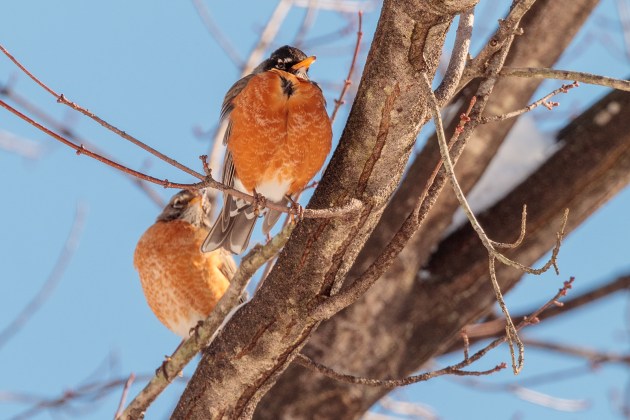
Robins, like most birds, have layers of feathers that perform different functions. When temperatures drop, robins puff the fine, downy feathers closest to their bodies to keep heat in, cold out. The outer feathers act like a kind of overcoat, shedding water and moisture and helping to regulate the bird’s temperature. (It’s an adaptation not limited to robins. Most birds with down feathers fluff them to regulate body heat).
The anatomy of a robin’s (and other bird species) also contributes to their cold adaptations. The bird experts over at the Cornell Lab explain it very well. The simplified version is that “most birds don’t succumb to frostbite because there is so little fluid in the cells of their feet, and their feet are mostly tendons and bones with little muscle or nerve tissue.”
So while blood does flow to their legs and feet, most birds (including robins) benefit from a very fast circulatory system and a “countercurrent heat exchange system.” Because bird legs are thin, the vessels that move blood from the heart to the feet and back again are very close together. That proximity means, per Cornell, “blood flowing back to the body is warmed by blood flowing to the feet. The newly cooled blood in the feet lowers heat loss from the feet, and the warmed blood flowing back into the body prevents the bird from becoming chilled.”
Robins: The Tell-Tale Birds of Spring
If robins are around in winter, why have they always been associated with the beginning of spring in the U.S.? Most likely it has to do with ground thaw, snow melt, and territorial behaviors like singing, worm hunting and nest building. But mostly, it’s the singing.
According to Journey North, which has a fantastic Q+A section I highly recommend for the robin-curious, “the robin’s song remains a reliable indicator that the first wave of spring migration has reached you. This song is one of the first signs that robins are switching from winter behavior to courtship and nesting behaviors associated with spring.”
Robins tend to move north as the ground thaws. The availability of high protein prey, especially worms that emerge with warmer, often wetter weather, is when a robin’s thoughts turn to procreation. And that’s the end of the cooperative fall and winter behaviors.
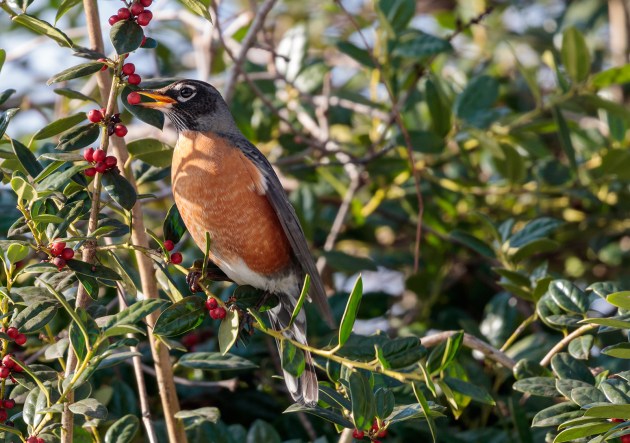
Which is one of the reasons many robins (primarily males) may stay through harsher winters instead of booking it to St. Petersburg: first access to the choicest nesting grounds. Breeding season is when robins also become more visible with mating displays, nest-building and a lot of time on the ground hunting for the tastiest worms. Until then, they’re all about the berries.
You Can Help Robins with Science from Your Own Backyard
Like many species, including other birds, scientists are starting to see some changes in robin behavior that is likely attributable to climate change. One study of American robins migrating to and from Canada’s boreal forest, showed that they’re beginning to journey south on average about 12 days earlier than in past years, or five days earlier per decade since 1994.
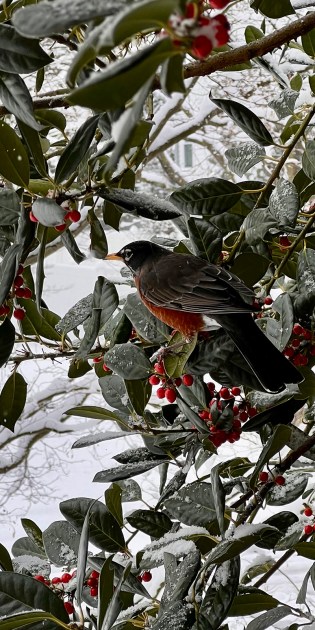
If you want to help scientists studying birds, there are several ways to contribute your observations (not just for robins, but for many of the species you can see outside your windows).
Journey North
You can submit your robin observations directly on the Journey North site (and check out their other migration-related citizen science projects). They also have 2025 maps tracking sightings so you can see where American robins (and other signs of spring) are being observed and follow along (and contribute to) the wanderings of Turdus migratorius.
Cornell Lab of Ornithology
The Cornell Lab has a number of different ways you can contribute to science for birds. Your sightings tracked on eBird (free) contribute to worldwide data for birding, science, and conservation. Want to know what birds are being seen in your neighborhood, eBird has a feature for that. If you’re new to birding, check out their genius birding ID app, Merlin.
You can also contribute to Project FeederWatch (requires subscription) by counting birds at your feeder from November through April. Your observations help scientists monitor changes in the abundance and distribution of birds, including the influence of changes in habitat, disease, and climate.
And mark your calendars for the 2025 Great Backyard Bird Count (February 14-17). Spend time in your favorite places watching birds—then report them to Cornell! It’s easy to participate, “in as little as 15 minutes notice the birds around you. Identify them, count them, and submit your counts to help scientists better understand and protect birds around the world. You can see the results from 2024 here.
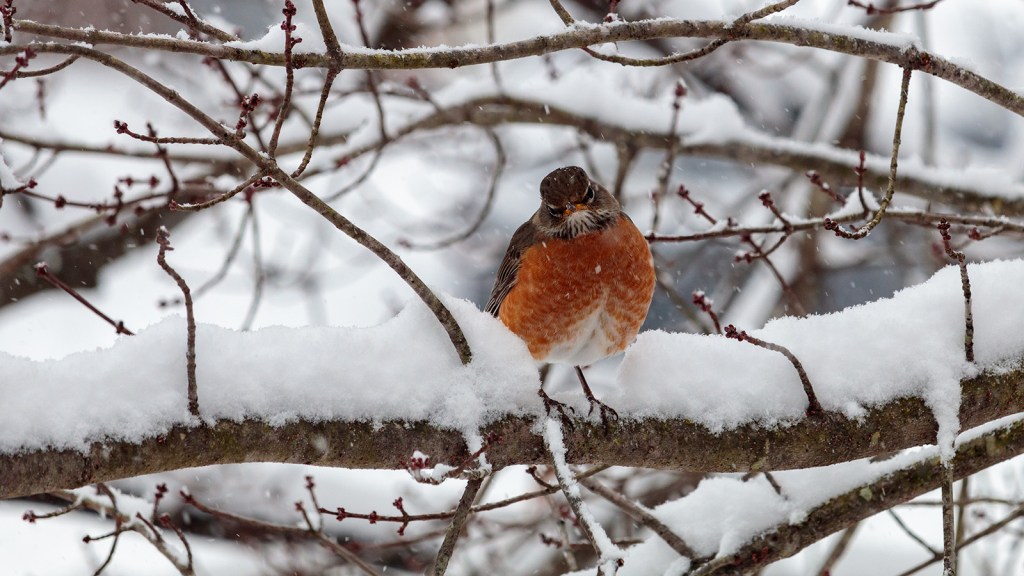



I live in FtWorth,Texas and we are having a terrific amount of robins in February 2021. so happy to have them ?
I’ve seen robins here in St. Louis in the county along a river bed near our home all winter in the past but this is the first time they have hung around our neighborhood. This is definitely a change in their habits. After the robins ate all the berries around here, I have put out dried chopped cranberries and fruit and dry mealworms, and they eat that. Also have a heated birdbath that all of the bite enjoy.
I saw a female robin this morning. I’m in Austin, Texas and we just came thru the worst freeze we have had for I don’t know how many years. Yesterday it got up in the 50’s, today the 70’s, and the previous week we were in the teens and single digits with 8 to 10+ inches of snow. This robin stayed just far enough from me in a yard, didn’t try to fly away, but hopped around the yard. Makes me wonder if she is planning on nesting in the nearby trees. Her pictures are on my fb page.
2/21/21 Flock of robins around my Okemos home, drinking from heated bath about a week ago, yesterday and this morning, from the thawed water in gutter yesterday afternoon. Last week bright red scat, lumpy–probably seeds, probably from wild honeysuckle berries? Today brown, lumpy scat plus some more ‘traditional’ bird looking.
Today is 2/21/21 and in my 81 years this is the first time I have ever saw a male robin in the winter. We live in Williamston, Michigan where the temperature was below zero two days ago, and today’s temp only reached a high of 32 degrees. The robin was sitting in a flowering berry tree that the squirrels eat from all winter. The tree is about picked clean, but the robin was eating one of the few berries left. We have very little open ground in our yard, only a place we shovel out for the dog to do her business, the rest of the yard is three and four foot snow banks so I was really, really stunned to see a robin sitting in a tree .I will put out some fresh water as you suggest. We do have several bird feeders that we fill a couple times a day,some suet blocks, as well as food for the squirrels that the deer help themselves to also. I sincerely hope this robin finds enough to eat, and a warm place to sleep.
I live in Richmond, Texas, just west of Houston, and saw a Robin visit my backyard during our snow / ice storm and 5 days of below freezing temperatures.
I put out extra birdseed, which attracted birds that don’t typically visit our backyard.
It was the first time I have ever seen a Robin in this area.
We saw lots of Robins during the extreme cold weather here in kirbyville, Tx. The Robins were all very fat. I enjoyed reading your article because I was wondering why i was seeing so many in the cold weather.
Feb. 21, 2021. We moved back into our house on the 18th of February after spending a couple of nights with our daughter who had not lost power during our most unusual period of very cold temperatures and heavy snow. I opened the miniblinds that opened into our backyard and saw a most unusual sight…… The leafless tree in our backyard was covered with what appeared to be many fluttering leaves. Then as I watched, the “leaves” took flight. A large number of small birds flew out across the neighborhood. One chubby little one stayed on top of the fence long enough for me to see the coloring and feel sure these were robins. I am 83 years old and do not ever remember seeing this same event before, certainly not in this area in North Texas where we have lived for over forty years!
I was so happy to have this article pop up on my Kindle this morning and give Lisa’s explanation to me!
ROCKFORD, ILLINOIS FLOCKS HAVE BEEN ABOUT FOR OVER A MONTH NOW.
QUESTION: I have some old feather pillows that if tossed about my yard would any birds use them for nesting?
Reminder for humming bird safety, PLEASE REMOVE SYNTHETIC DECORATIVE SPIDER WEBBING.
From Central Ohio, we’ve seen several robins, haven’t see large flocks though, throughout this cold, snowy winter. They have been the only bird we’ve seen eating chokeberries that were plentiful for the first time this year. We keep two heated bird baths going all late fall, winter and into spring. The robins love to bathe and drink from them, especially in the mornings. We have tray feeders with homemade suet cakes containing seeds, lard, peanut butter and mealworms. They like those so much. They also clear our serviceberry bushes of all berries in late spring. Robins are wonderful! Thanks for your helpful information!
Yesterday morning, Feb 20, 2021, I was awakened by birds. Flocks of birds swirling all around my home chirping loudly. I viewed an awesome sight! A berry shrub was being shaken by a flock of these birds. It was crazy, but after reading the article about the robins, everything made sense!!! I was in awe for sure. The Robin is my Michigan state bird. I viewed this event in Texas. I’m so glad they come to visit me and my yard!
I live outside of Medina, Tx and we had an unusual snow event last week and now there are red breasted robins all over our property. Since it rarely snows here it is something I have just observed this year. We have about 50 acres and they are everywhere. All the snow has melted and our temperatures are rising to the 60’s- 70’s. Thought you might like this info. Leslie
We received 5-6 inches of snow in McKinney, Texas this past week. One day, as the snow was melting off of the roof of the house behind us, I noticed a flock of over 20 robins flew onto the roof. They seemed to be sunning for about 10 minutes! I’ve never seen them this early before Spring !
Wow finally an answer to the groups of robins messing with my brain. I thought I was seeing things when I first spotted these flocks of robins by open water area of my frozen pond. They were hanging out in single digit temps during January in Michigan. I couldn’t believe it. I’d never seen this behavior before now. I can now rest assured I’m joined by others who are seeing such amazing sightings
I live in Bellville, TEXAS and I’be never seen so many Robins in my 72 years on this earth. They look like grazing cattle, but smaller. All females.